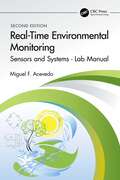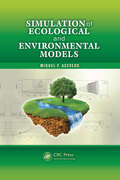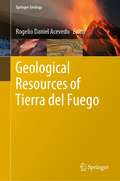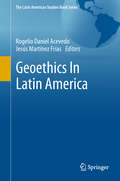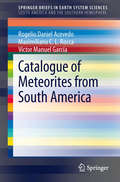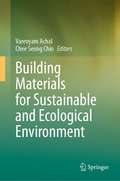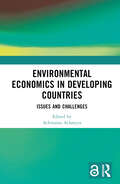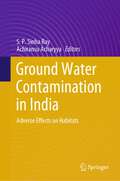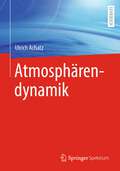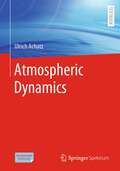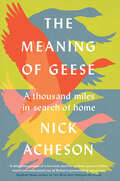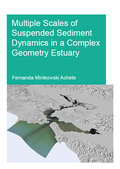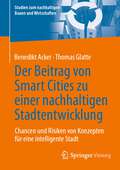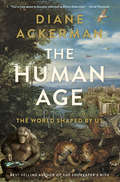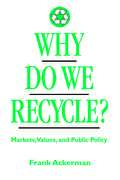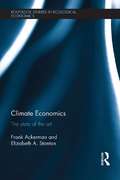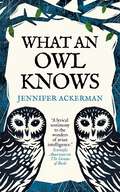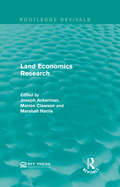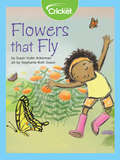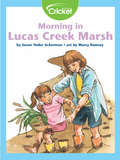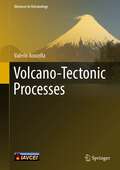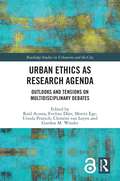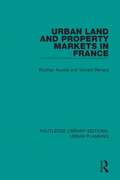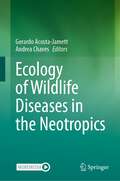- Table View
- List View
Real-Time Environmental Monitoring: Sensors and Systems - Lab Manual
by Miguel F. AcevedoThis lab manual is a companion to the second edition of the textbook Real-Time Environmental Monitoring: Sensors and Systems. Tested in pedagogical settings by the author for many years, it includes applications with state-of-the-art sensor technology and programs such as R, Python, Arduino, PHP, HTML, and SQL. It helps students and instructors in science and engineering better understand how to use and design a variety of sensors, and how to build systems and databases when monitoring different environments such as soil, water, and air. Examples of low-cost and open-access systems are included and can serve as the basis of learning tools for the concepts and techniques described in the textbook. Furthermore, the manual provides links to websites and scripts in R that allow learning how to analyze a variety of datasets available from repositories and databases maintained by many agencies and institutions. The first hands-on environmental monitoring lab manual written in tutorial style and classroom tested. Includes 14 lab guides that parallel the theory developed in 14 chapters in the companion textbook. Provides clear step-by-step protocols to understand basic and advanced theory through applicable exercises and problems. Injects a practical implementation of the existing textbook. A valuable guide for students and practitioners worldwide engaged in efforts to develop, employ, and maintain environmental monitors. Intended for upper-level undergraduate and graduate students taking courses in electrical engineering, civil and environmental engineering, mechanical engineering, geosciences, and environmental sciences, as well as instructors who teach these courses. Professionals working in fields such as environmental services, and researchers and academics in engineering will also benefit from the range of topics included in this lab manual.
Simulation of Ecological and Environmental Models
by Miguel F. AcevedoGiven the importance of interdisciplinary work in sustainability, Simulation of Ecological and Environmental Models introduces the theory and practice of modeling and simulation as applied in a variety of disciplines that deal with earth systems, the environment, ecology, and human-nature interactions. Based on the author's many years of teaching g
Geological Resources of Tierra del Fuego (Springer Geology)
by Rogelio Daniel AcevedoThe CADIC’s Geological Resources Program will soon turn 40 years of fruitful development. During this period many projects were carried out and others remain to be implemented. In the course of time three generations of researchers have been formed. Mentioning names would be unfair to those that could be involuntarily omitted. There is still a long way to go. The eagerness for knowledge should not stop. This book is a tribute to all those people who have worked in the different projects of pure and applied science, and educational, and human resources training, granted to this founding program and associated laboratories of the regional center of CONICET in Ushuaia, Tierra del Fuego, Argentina. The twenty papers which constitute this book have a genuine Latin appeal, having been written by 50 authors based in Argentina and Spain. All this contributions are concerned with Fuegian geological resources. Everyone concerned with this work hopes that it will prove a fitting and lasting memorial to Nacho Subías, whose personal contribution to our knowledge of this geology was outstanding.
Geoethics In Latin America (The Latin American Studies Book Series)
by Rogelio Daniel Acevedo Jesús Martínez FríasThis book studies geoethics in Latin America and offers comprehensive research on geoethics and geoeducation. Its respective chapters explore geoethics in relation to UNESCO geoparks, mining activities in Latin America, natural hazards and risk management. Geoethics is a key discipline in the field of Earth and Planetary Sciences, and not only includes scientific, technological, methodological and social-cultural aspects, but also addresses the need to consider appropriate protocols, scientific integrity issues and a code of good practice when studying the abiotic world.The position of Latin America’s recently created geoethics associations is based on protection of the environment, together with a reassurance that the balance of nature and the rights of human beings to enjoy it will be preserved.
Catalogue of Meteorites from South America (SpringerBriefs in Earth System Sciences)
by Rogelio Daniel Acevedo Maximiliano C. L. Rocca Víctor Manuel GarcíaThe first Catalogue of Meteorites from South America includes new specimens never previously reported, while doubtful cases and pseudometeorites have been deliberately omitted. The falling of these objects is a random event, but the sites where old meteorites are found tend to be focused in certain areas, e. g. in the deflation surfaces in Chile's Atacama Desert, due to favorable climate conditions and ablation processes. Our Catalogue provides basic information on each specimen like its provenance and the place where it was discovered (in geographic co-ordinates and with illustrative maps), its official name, its classification type (class, and if applicable, weathering grade and shock stage), if it was seen falling or was found by chance, its total mass or weight, the institution where it is held, and the most important bibliographic references about it.
Building Materials for Sustainable and Ecological Environment
by Varenyam Achal Chee Seong ChinThis book uses theories, hypotheses, policies, practical insights and case studies to introduce and elucidate green building materials for sustainable construction. Cement is the most widely used building material in construction; however, it is not sustainable, being responsible for 7% of global carbon dioxide emissions and consuming huge quantities of energy. In order to limit the ecological damage, sustainable building materials are needed. Ecosystems are a source of important lessons and models for transitioning the built environment onto a sustainable path that opens options for sustainable building material in construction. The book provides a guide for readers seeking knowledge on sustainable building materials with the potential to lower environmental impact by reducing CO2 emission throughout the building’s lifecycle. The book is motivated by recent rapid advances in sustainable building materials production, including green building materials made of industrial by-products and recycled wastes, earth materials, plant-based materials, microbial-based materials or supplementary cementitious materials, to reduce the environmental impacts of traditional building materials. Discussing the development and applications of various sustainable building materials, including related case studies, and addressing the environmental issue with a holistic and systematic approach that creates an ecology of construction for sustainability in infrastructures, it offers promising solutions to achieve renewable and sustainable building materials for the future.
Environmental Economics in Developing Countries: Issues and Challenges
by Achiransu AcharyyaThe COVID-19 pandemic has laid bare the vulnerabilities of socio-economic systems globally and exposed the risks that natural capital degradation imposes on human health, economy, and society. This book studies the environmental challenges faced by developing economies in a post-COVID-19 world. Exploring diverse case studies from South Asia and Sub-Saharan Africa, the volume discusses the impact that economic development and, recently, COVID-19 has had on the environment, ecology, and economy of these regions. It analyses nature conservation policies aimed at minimizing ecological damage arising from economic development and discusses the policy objectives of sustainable development. It also highlights the significant role that environmental economics networks have played in capacity building, framing of policies using ecological economics tools, and developing a local leadership trained in addressing local sustainability issues. An important contribution to the study of environmental economics of the Global South, the book will be of interest to students and researchers of economics, environment, development studies, development economics, environmental policies, and South Asia studies. It will also be useful for policymakers and NGOs working in this field.
Ground Water Contamination in India: Adverse Effects on Habitats
by Achiransu Acharyya S. P. Sinha RayThis book examines contamination in groundwater. Groundwater is a lifeline for most countries of the world. 90% of the Indian population rely on groundwater-based drinking water as safe mode of water supply. The terminology contamination in groundwater along with adverse effect on habitats, suggests the impact of such contamination in not only for drinking water, but also for agricultural irrigation. In addition, polluted groundwater causes adverse health hazards including social aspects that affect wider communities. Impacts on plant life also are equally threatening. This book provides readers with an insight into groundwater contamination in India. The economic loss associated with this devastating phenomenon is also studied in detail, which has a direct bearing to the country's GDP.
Atmosphärendynamik
by Ulrich AchatzDieses Lehrbuch richtet sich an Studierende der Meteorologie sowie an Forschende zu theoretischen und numerischen Aspekten von Wetter und Klima. Der vorliegende Text konzentriert sich auf das Wesentliche und bleibt dabei gleichermaßen gründlich. Alle zum Verständnis notwendigen physikalischen Konzepte werden eingeführt.Einleitend erfolgt eine Herleitung der Grundgleichungen der Atmosphärendynamik. Diese werden nachfolgend herangezogen, um wesentliche Aspekte von Wetter und Klima zu erläutern, zu denen unter anderem die Mechanismen hinter den wirbelartigen Bewegungen auf der täglichen Wetterkarte gehören. Als Mittel zu einer effizienten Analyse von atmosphärischen Wellen folgt die Vereinfachung der Dynamik mithilfe der Flachwassergleichungen. Daraufhin wird unter Zuhilfenahme der quasigeostrophischen Theorie das Auftreten extratropischer Wettersysteme begründet. Dem schließt sich eine ausführliche Betrachtung der globalen atmosphärischen Zirkulation an, die maßgeblich dem Einfluss durch Rossby- und Schwerewellen unterliegt. Auch die spezifischen Eigenschaften der atmosphärischen Grenzschicht werden diskutiert. Im Mittelpunkt steht hier die Wechselwirkung zwischen Turbulenz und mittlerer Strömung.Im Zuge der Betrachtungen wird die Leserschaft mit wesentlichen theoretischen Konzepten des Gebiets vertraut gemacht. Hierzu zählen Entropie und potentielle Temperatur, potentielle Vorticity, Instabilitätstheorie, Reynoldsgleichungen, Mehrskalenasymptotik, WKB-Theorie, Wellenwirkung, Eliassen-Palm-Fluss, transformiertes Eulermittel, kritische Schichten, Wellenbeugung und vieles mehr.Der Text wird durch Anhänge zu mathematischen Methoden und weiteren Vertiefungen ergänzt. Kapitelzusammenfassungen helfen, den Blick auf das Wesentliche zu bewahren. Ergänzende Leseempfehlungen regen dazu an, das erworbene Wissen zu vertiefen und zu erweitern.
Atmospheric Dynamics
by Ulrich AchatzThis textbook is intended for both undergraduate and graduate courses in meteorology and atmospheric sciences, as well as for researchers working on theoretical and numerical aspects of weather and climate or on geophysical fluid dynamics. The treatment is concise, thorough, and self-contained. All necessary concepts are introduced, and the reader is given explicit guidance on all mathematical steps.The book begins with a derivation of the equations of motion. These are then used to discuss fundamental aspects of weather and climate. The mechanisms behind vortical motions, that are known from the daily weather map, are discussed. Shallow-water theory is introduced as a tool for an efficient analysis of key concepts, such as atmospheric waves and synoptic-scale vortices. Quasigeostrophic theory is described and then used to explain the occurrence and mechanisms of extratropical weather by means of baroclinic instability. The specific properties of the atmospheric boundary layer are discussed, with a focus on the interaction between turbulence and mean flows. This is followed by a detailed look at the global atmospheric circulation, highlighting its control by Rossby waves and gravity waves.At the same time, the reader is introduced to essential concepts that find applications in the field, such as balance by geostrophic and hydrostatic equilibrium, the role of entropy and potential temperature, potential vorticity, the Kelvin theorem, instability theory, the Reynolds equations, Eliassen-Palm and pseudo-momentum flux, multi-scale asymptotics, WKB theory, wave action, the transformed Eulerian mean, critical layers, and wave refraction.The text is supplemented by appendices on important mathematical concepts and further elaborations of the main text. Chapter summaries and reading recommendations help the reader not merely to keep focus on the essentials, but just as well to broaden the horizon.
The Meaning of Geese: A Thousand Miles in Search of Home
by Nick Acheson‘A magisterial diary for bird lovers.’ Observer ⭐⭐⭐⭐ The Telegraph As seen on BBC Winterwatch 2023 ‘Honest, human and heart-grabbing. I loved this book so much.’ Sophie Pavelle, author of Forget Me Not ‘Delightful’ Stephen Moss, author of Ten Birds that Changed the World ‘Fascinating and thought-provoking’ Jake Fiennes, author of Land Healer ‘Awe-filled and absorbing’ Nicola Chester, author of On Gallows Down The Meaning of Geese is a book of thrilling encounters with wildlife, of tired legs, punctured tyres and inhospitable weather. Above all, it is the story of Nick Acheson’s love for the land in which he was born and raised, and for the wild geese that fill it with sound and spectacle every winter. Renowned naturalist and conservationist Nick Acheson spent countless hours observing and researching wild geese, transported through all weathers by his mother’s 40-year-old trusty red bicycle. He meticulously details the geese’s arrival, observing what they mean to his beloved Norfolk and the role they play in local people’s lives – and what role the birds could play in our changing world. During a time when many people faced the prospect of little work or human contact, Nick followed the pinkfeet and brent geese that filled the Norfolk skies and landscape as they flew in from Iceland and Siberia. In their flocks, Nick encountered rarer geese, including Russian white-fronts, barnacle geese and an extremely unusual grey-bellied brant, a bird he had dreamt of seeing since thumbing his mother’s copy of Peter Scott’s field guide as a child. To honour the geese’s great athletic migrations, Nick kept a diary of his sightings as well as the stories he discovered through the community of people, past and present, who loved them, too. Over seven months Nick cycles over 1,200 miles – the exact length of the pinkfeet’s migration to Iceland.
Multiple Scales of Suspended Sediment Dynamics in a Complex Geometry Estuary (IHE Delft PhD Thesis Series)
by Fernanda Minikowski AcheteMany estuaries are located in urbanized, highly engineered environments. Cohesive sediment plays an important role due to its link with estuarine health and ecology. An important ecological parameter is the suspended sediment concentration (SSC) translated into turbidity levels and sediment budget. This study contributes to investigate and forecast turbidity levels and sediment budget variability at San Francisco Bay-Delta system at a variety of spatial and temporal scales applying a flexible mesh process-based model (Delft3D FM). It is possible to have a robust sediment model, which reproduces 90% of the yearly data derived sediment budget, with simple model settings, like applying one mud fraction and a simple bottom sediment distribution. This finding opens the horizon for modeling less monitored estuaries.Comparing two case studies, i.e. the Sacramento-San Joaquin Delta and Alviso Slough, a classification for estuaries regarding the main sediment dynamic forcing is proposed: event-driven estuary (Delta) and tide-driven estuary (Alviso Slough). In the event-driven estuaries, the rivers are the main sediment source and the tides have minor impact in the net sediment transport. In the tide-driven estuaries, the main sediment source is the bottom sediment and the tide asymmetry defines the net sediment transport.This research also makes advances in connecting different scientific fields and developing a managerial tool to support decision making. It provides the basis to a chain of models, which goes from the hydrodynamics, to suspended sediment, to phytoplankton, to fish, clams and marshes.
Der Beitrag von Smart Cities zu einer nachhaltigen Stadtentwicklung: Chancen und Risiken von Konzepten für eine intelligente Stadt (Studien zum nachhaltigen Bauen und Wirtschaften)
by Benedikt Acker Thomas GlatteDieses Fachbuch vermittelt einen umfassenden Überblick über den Beitrag, welchen eine Smart City zu einer nachhaltigen Stadtentwicklung leisten kann. Unter Bezugnahme aktuell präsenter Megatrends erfolgt eine systematische Einordnung der Rolle der Immobilienwirtschaft im umfassenden Konstrukt einer intelligenten Stadt. Mittels Analysen vielversprechender Konzepte im Bereich der Smart City wird dabei der zusätzliche Mehrwert herausgearbeitet, welcher im Kontext der Nachhaltigkeit bei der Modernisierung und Revitalisierung von Gebäuden und Quartieren entstehen kann.
The Human Age: The World Shaped By Us
by Diane AckermanAs Diane Ackerman writes in her brilliant new book, The Human Age, "our relationship with nature has changed...radically, irreversibly, but by no means all for the bad. Our new epoch is laced with invention. Our mistakes are legion, but our talent is immeasurable." Ackerman is justly celebrated for her unique insight into the natural world and our place in it. In this landmark book, she confronts the unprecedented reality that one prodigiously intelligent and meddlesome creature, Homo sapiens, is now the dominant force shaping the future of planet Earth. Humans have "subdued 75 percent of the land surface, concocted a wizardry of industrial and medical marvels, strung lights all across the darkness." We tinker with nature at every opportunity; we garden the planet with our preferred species of plants and animals, many of them invasive; and we have even altered the climate, threatening our own extinction. Yet we reckon with our own destructive capabilities in extraordinary acts of hope-filled creativity: we collect the DNA of vanishing species in a "frozen ark," equip orangutans with iPads, and create wearable technologies and synthetic species that might one day outsmart us. With her distinctive gift for making scientific discovery intelligible to the layperson, Ackerman takes us on an exhilarating journey through our new reality, introducing us to many of the people and ideas now creating--perhaps saving--our future and that of our fellow creatures. A beguiling, optimistic engagement with the changes affecting every part of our lives, The Human Age is a wise and beautiful book that will astound, delight, and inform intelligent life for a long time to come.
Poisoned for Pennies: The Economics of Toxics and Precaution
by Frank Ackerman"Cost-benefit analysis" is a term that is used so frequently we rarely stop to think about it. But relying on it can lead to some dubious conclusions, as Frank Ackerman points out in this eye-opening book. For example, some economists have argued that states should encourage--and even subsidize--cigarette smoking by citizens because smoking will shorten life spans and therefore reduce the need and expense of caring for the elderly. How did the economists reach that conclusion? The answer is cost-benefit analysis, Ackerman explains. Then in clear, understandable language, he describes an alternative, precautionary approach to making decisions under uncertainty. Once a mere theory, the precautionary principle has now been applied in practice through the European Union's REACH protocol. Citing major studies, many of which he has directed, he shows that the precautionary approach has not only worked, but has been relatively cheap. Poisoned for Pennies shows how the misuse of cost-benefit analysis is impeding efforts to clean up and protect our environment, especially in the case of toxic chemicals. According to Ackerman, conservatives--in elected office, in state and federal regulatory agencies, and in businesses of every size--have been able to successfully argue that environmental clean-up and protection are simply too expensive. But he proves, that is untrue in case after case. Ackerman is already well known for his carefully reasoned attacks on the conventional wisdom about the costs of environmental regulation. This new book, which finds Ackerman ranging from psychological research to risk analysis to the benefits of aggressive pesticide regulation, and from mad cow disease to lead paint, will further his reputation as a thought leader in environmental protection. We can't afford not to listen to him.
Why Do We Recycle?: Markets, Values, and Public Policy
by Frank AckermanThe earnest warnings of an impending "solid waste crisis" that permeated the 1980s provided the impetus for the widespread adoption of municipal recycling programs, and since that time America has witnessed a remarkable rise in public participation in recycling activities. Recently, however, a backlash against these programs has developed. A vocal group of "anti-recyclers" has appeared, arguing that recycling is not an economically efficient strategy for addressing waste management problems. In Why Do We Recycle? Frank Ackerman examines the arguments for and against recycling, focusing on the debate surrounding the use of economic mechanisms to determine the value of recycling. Based on previously unpublished research, Ackerman presents an alternative view of the theory of market incentives, challenging the notion that setting appropriate prices and allowing unfettered competition will result in the most efficient level of recycling. Among the topics he considers are: externality issues, the landfill crisis and disposal facility siting, container deposit legislation, environmental issues that fall outside of market theory, costs and benefits of municipal recycling programs, life-cycle analysis and packaging policy, the impacts of production in extractive and manufacturing industries, composting and organic waste management, economics of conservation, and material use and long-term sustainability. Ackerman explains why purely economic approaches to recycling are incomplete and argues for a different kind of decisionmaking, one that addresses social issues, future as well as present resource needs, and non-economic values that cannot be translated into dollars and cents. Backed by empirical data and replete with specific examples, the book offers valuable guidance for planners and policymakers as well as an accessible introduction to the subject for students and citizens interested in the social, economic, and ethical underpinnings of recycling efforts.
Climate Economics: The State of the Art (Routledge Studies in Ecological Economics)
by Frank Ackerman Elizabeth A. StantonClimate science paints a bleak picture: The continued growth of greenhouse gas emissions is increasingly likely to cause irreversible and catastrophic effects. Urgent action is needed to prepare for the initial rounds of climatic change, which are already unstoppable. While the opportunity to avert all climate damage has now passed, well-designed mitigation and adaptation policies, if adopted quickly, could still greatly reduce the likelihood of the most tragic and far-reaching impacts of climate change. Climate economics is the bridge between science and policy, translating scientific predictions about physical systems into projections about economic growth and human welfare that decision makers can most readily use but it has too often consisted of an overly technical, academic approach to the problem. Getting climate economics right is not about publishing the cleverest article of the year but rather about helping solve the dilemma of the century. The tasks ahead are daunting, and failure, unfortunately, is quite possible. Better approaches to climate economics will allow economists to be part of the solution rather than part of the problem. This book analyzes potential paths for improvement.
What an Owl Knows: The New Science of the World's Most Enigmatic Birds
by Jennifer Ackerman*THE NEW YORK TIMES BESTSELLER* &‘And if anyone knows anything about anything…it's Owl who knows something about something.&’ Winnie-the-Pooh, A. A. Milne From prehistoric cave paintings to the prints and etchings of Picasso, owls have captivated and inspired us for millennia. Whether they appear as ancient Athenian symbols of wisdom, ghostly harbingers of death, or the cuddly sidekicks of Harry Potter and Winnie the Pooh, these birds have continued to fascinate and disturb us in equal measure. Through revelatory new behavioural research, Jennifer Ackerman provides an intimate glimpse into these magnificent creatures&’ lives. From the evolutionary quirks behind their silent flight and rotating heads, to their romantic relationships and parenting styles, What an Owl Knows brings the rich natural history of owls to life. Deftly weaving together science and art, Ackerman journeys into the owl&’s moonlit world and asks: what is it about these birds that so enthrals us?
Land Economics Research: Papers Presented At A Symposium Held At Lincoln, Nebraska, June 16-23, 1961 (Routledge Revivals)
by Joseph Ackerman Marion Clawson Marshall HarrisOriginally published in 1962, Land Economics Research brings together papers presented at a symposium in Nebraska in 1961 which deal with ideas, theories and suggestions in land economics to encourage problem-solving in American land issues. This report draws on all types of land, all situations and all economics problems related to land issues. This title will be of interest to students of Environmental Studies and Economics as well as professionals.
Flowers that Fly
by Susan Yoder AckermanSimon teaches his little cousin Adeline about how to grow a garden that will attract beautiful butterflies.
Morning in Lucas Creek Marsh
by Susan Yoder AckermanThomas, Madeline, and their mother go on a walk through a Virginia tidewater marsh, spotting all kinds of wildlife along the way.
Volcano-Tectonic Processes (Advances in Volcanology)
by Valerio AcocellaVolcanoes have terrified and, at the same time, fascinated civilizations for thousands of years. Many aspects of volcanoes, most notably the eruptive processes and the compositional variations of magma, have been widely investigated for several decades and today constitute the core of any volcanology textbook. Nevertheless, in the last two decades, boosted by the availability of volcano monitoring data, there has been an increasing interest in the pre-eruptive processes related to the shallow accumulation and to the transfer of magma approaching the surface, as well as in the resulting structure of volcanoes. These are innovative and essential aspects of modern volcanology and, as driving volcanic unrest, their understanding also improves hazard assessment and eruption forecasting. So far, the significant progress made in unravelling these volcano-tectonic processes has not been supported by a comprehensive overview.This monograph aims at filling this gap, describing the pre-eruptive processes related to the structure, deformation and tectonics of volcanoes, at the local and regional scale, in any tectonic setting. The monograph is organized into three sections (“Fundamentals”, “Magma migration towards the surface” and “The regional perspective”), consisting of thirteen chapters that are lavishly illustrated. The reader is accompanied in a journey within the volcano factory, discovering the processes associated with the shallow accumulation of magma and its transfer towards the surface, how these control the structure of volcanoes and their activity and, ultimately, improve our ability to estimate hazard and forecast eruption.The potential readership includes any academic, researcher and upper undergraduate student interested in volcanology, magma intrusions, structural geology, tectonics, geodesy, as well as geology and geophysics in general.
Urban Ethics as Research Agenda: Outlooks and Tensions on Multidisciplinary Debates (Routledge Studies in Urbanism and the City)
by Raúl Acosta Eveline Dürr Moritz Ege Ursula Prutsch Clemens Van Loyen Gordon M. WinderThis book provides an outline for a multidisciplinary research agenda into urban ethics and offers insights into the various ways urban ethics can be configured. It explores practices and discourses through which individuals, collectives and institutions determine which developments and projects may be favourable for dwellers and visitors traversing cities. Urban Ethics as Research Agenda widens the lens to include other actors apart from powerful individuals or institutions, paying special attention to activists or civil society organizations that express concerns about collective life. The chapters provide fresh perspectives addressing the various scales that converge in the urban. The uniqueness of each city is, thus, enriched with global patterns of the urban. Local sociocultural characteristics coexist with global flows of ideas, goods and people. The focus on urban ethics sheds light on emerging spaces of human development and the ways in which ethical narratives are used to mobilize and contest them in terms of the good life. This timely book analyses urban ethical negotiations from social and cultural studies, particularly drawing on anthropology, geography, and history. This volume will be of interest to scholars, researchers and practitioners interested in ethics and urban studies.
Urban Land and Property Markets in France (Routledge Library Editions: Urban Planning #1)
by Rodrigo Acosta Vincent RenardOriginally published in 1994, Urban Land and Property Markets in the United Kingdom, adopts a perspective that encompasses the distinctive nature of the legal framework, land law, property market and procedures of Scotland, England and Wales. The book provides detailed accounts of the structure of property, planning and tax law governing urban land and property markets, registration procedures and transactions charges, market processes and how they all work in practice. The book is based on a report commissioned by the German Federal Government as part of a five-country study completed in 1991.
Ecology of Wildlife Diseases in the Neotropics
by Gerardo Acosta-Jamett Andrea ChavesThis contributed volume focuses on the Neotropical region, and explores the environmental, ecological and socio-economic components that facilitate the emergence of zoonotic diseases. This book highlights the primary ecological, environmental, social, and economic variables associated with the risk of maintenance, transmission, and dissemination of emerging, re-emerging, and neglected infectious diseases, in which Neotropical vertebrates are involved. It compiles up-to-date knowledge and research for the neotropical region, as well as discusses the current needs of knowledge improvement. The chapters include various examples of the cycles of infectious diseases, all with world-wide relevance where neotropical wild vertebrates are affected or involved.
